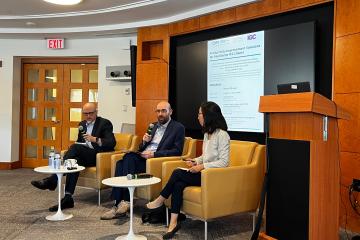
Expanding access to financing for SMEs

As of 2018, the SME financing gap was estimated to be US$5 trillion, and access to finance is the leading constraint for businesses in nearly half of the countries in sub-Saharan Africa. Access to finance is critical for firms to grow, innovate, and create jobs that help workers escape poverty. However, small- and medium-sized enterprises (SMEs) worldwide are often underserved by financial institutions. Banks, especially those based in lower- and middle-income countries, may lack the information needed to inform lending decisions for SMEs. And while microcredit products that are targeted towards microentrepreneurs are widespread, the small size of the loans may not meet the unique needs of SMEs.
In this blog, we explore early findings on SME financing for policymakers interested in strategies to reduce the gap, while recognizing that more research is needed and that there is not yet a consensus on impacts for borrowing SMEs. There are also lessons to be learned from a rich body of research around microcredit, including the potential benefits of loan design tweaks and asset-based lending, which may also be applicable to SME financing.
Who the borrower is matters
Findings from several studies suggest that some firms can make more productive use of financial support than others. For example, SMEs in Egypt that received large loans did not increase profits by much on average. However, when researchers used psychological survey data to group firms by predicted performance, the top-ranking group increased their profits by 55 percent, while the lowest-ranking group's profits halved. In India, community members were able to accurately identify which local entrepreneurs would generate higher returns on capital. This finding was also observed in microcredit: in an early evaluation, borrowers with prior experience running a business generated twice as much revenue as firms who did not, six years after microcredit was introduced.
But if targeting finance to certain, high-potential firms is important, how can financial institutions go about identifying which SMEs to support in a cost-effective, scalable way? This is a key question for future research. Mobile phone usage data can be a low cost substitute for credit information, and is widely generated even in areas that have been historically harder for banks to reach. Artificial intelligence may also support decision-making. In the above evaluation in Egypt, researchers used machine learning methods to predict which firms would perform better than others. Another study used machine learning to accurately predict borrower performance on loans in China. However, evaluations of these methods are needed to determine the extent to which they exacerbate biases in lending.
Potential innovations to make SME financing more impactful and commercially viable
Early evaluations of microcredit found disappointing results on average, but findings from recent years suggest that innovations on the classic microcredit model can lead to greater impacts on beneficiaries. Two of these innovations could be applied to financing for SMEs: repayment flexibility and asset-based financing.
A recent J-PAL evidence review found that more flexible repayment terms, including options to defer repayments once or twice and longer grace periods, enabled firms to invest more or align their repayments with their cash flows. These ultimately led to stronger profits. While increased flexibility for borrowing firms might raise concerns about the sustainability or attractiveness of these models for lending institutions, we found that this tradeoff was not to be taken for granted. Default did not increase in three out of five evaluations of flexible microcredit products. Like microenterprises, SMEs can also face variable cash flows. Growth-oriented SMEs may also make higher-risk, higher-return investments than relatively smaller-scale microenterprises. Future randomized evaluations will enable us to understand the extent to which more flexible lending can also benefit SMEs while preserving commercial viability for lenders.
Asset-based financing or equity-like financing also holds promise for SMEs. In Pakistan, graduated microcredit clients who received access to financing for a business asset worth four times their original borrowing limit increased monthly profits by 11 percent and household income by 9 percent. In Kenya, individual goods sellers received access to an equity-like contract that financed a bike. To pay off the bike, beneficiaries paid fixed monthly payments plus 10 percent of their monthly profits. Individuals who received access to these contracts increased their monthly profits by 167 percent. Offering similar financial products to SMEs could facilitate large-scale capital investments while reducing risk for lending institutions by using the financed asset as collateral. However, revenue for the lender in Kenya was limited to the value of the bikes plus a premium. As an alternative, banks and SMEs may find contracts that provide the bank with a permanent stake in the company in exchange for a larger financial investment to be mutually beneficial.
Impacts of SME financing beyond beneficiary firms
Policymakers may be interested in how increasing access to financing for SMEs may impact local economies. In China, providing access to finance for small firms in marketplaces enabled them to hire more employees, attract more clients, and grow profits by CN¥ 126,400 (around USD$20,000 at the time of study) over comparison firms, a 24 percent increase. But these benefits were largely offset by a drop in customers and profits for competing firms that did not receive the same access to finance.
However, this greater degree of competition can also result in net benefits to local economies. For example, customers in the same evaluation enjoyed higher quality and more varied products that borrowing firms had introduced. In a non-experimental study in Brazil, after a national development bank introduced a policy increasing credit supply to SMEs, new firms were faster-growing and more resilient.
Research questions to move forward
A key challenge in SME finance is ensuring banks and other financial institutions find it sustainable. While not an exhaustive list, the below questions can help policymakers and donors understand how and why to improve access to financing for SMEs.
Identifying and targeting high-potential SMEs:
- What are cost-effective and scalable ways to identify high-potential SMEs?
- How can banks identify SMEs with high repayment performance?
- How should we develop the right data, incentives, and targeting tools?
Innovating on financial products for SMEs:
- How can credit products be tailored to meet SMEs’ needs?
- Do SMEs default more when offered more flexible lending terms?
- Do SMEs benefit from asset-based financing?
- Are asset-based financing and equity financing products sustainable for financial institutions to provide?
Indirect effects of access to finance:
- In what contexts does providing access to finance for SMEs harm business performance for non-borrowing firms? Why?
- Does expanding credit supply for SMEs generate a multiplier effect?
J-PAL Africa is excited to be seeding a dedicated program to further explore SME growth and financing topics in Africa as a route for job creation, poverty reduction, and prosperity. We are actively looking for partners and funders to join us as we establish a portfolio of research for evidence-based policies that can foster SME growth on the continent. Please reach out to Michael Hou at mhou@povertyactionlab.org to find out more.



